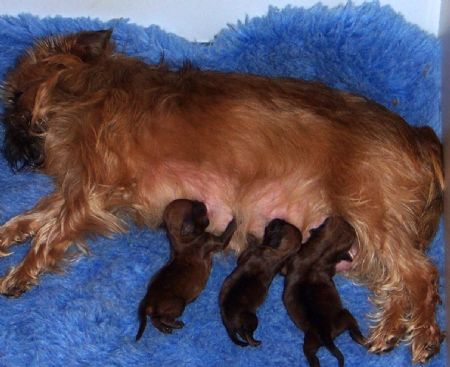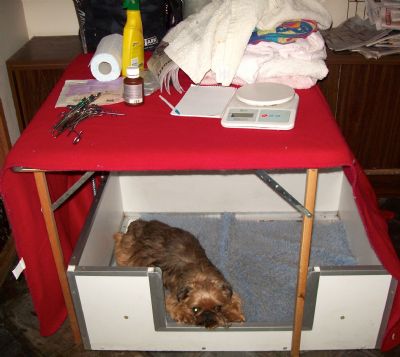Ask Dr Iain-Care of the Pregnant Bitch

Care of the pregnant bitch
Before contemplating pregnancy?
It’s important that your bitch’s vaccinations and worming schedules are up to date. While it is safe to vaccinate before the mating is achieved, it isn’t always safe to vaccinate after the mating when the bitch is in the first trimester of pregnancy. Some flea treatments can be risky to use during pregnancy but most heartworm or heartworm / flea combination products are safe, check the literature of the product you’ve been using.
I’m also hoping that you are following our Club’s recommendations that can be found in the Health Documents available on our website to all breeders and prospective puppy purchasers. This will mean that your bitch has passed her eye examination with a Veterinary Ophthalmologist. She should also have a reasonable Hip Dysplasia (HD) score, which if it is a little above the average for Griffons (currently 19) then at least the male stud dog has a score below the average. Hip X-rays should be done under a general anaesthetic otherwise the score will be misleading even if good positioning can be obtained. Ideally her patella scores should be no more than 1 in both hind legs. If she has had a MRI examination at a Veterinary Specialist Facility for Syringomyelia and Chiara-like Malformation (SM/CM) then you can refer to the BVA (British Veterinary Association) website for their recommendations as to what score the male dog should have in order to proceed with mating.
Obviously she should be otherwise assessed as healthy at her last annual veterinary examination. It is certainly worthwhile to have a blood and urine analysis carried out before proceeding with mating a bitch. Similarly, blood progesterone measurements when a bitch is in season can help accurately identify if ovulation is imminent. If the bitch has to travel or can only have one or two visits to the stud dog then having blood progesterone measurements is a must. Generally I want to do the first measurement no later than a week after pro-oestrus has started (i.e. when the vulva is swollen and there is that blood tinged discharge). Depending on the result, your vet may want to repeat the test up to two or three days later. Generally it is best to time the first mating a day after ovulation has been identified.
Vaginal swabs? When I first graduated we were doing these commonly for both timing when the bitch should be mated and for bacterial culture, usually at the request of the owner of the stud dog. Nowadays, blood progesterone testing is far more accurate than vaginal cytology. In many vet’s opinions, including mine, bacterial swabs are a waste of time and money which results in healthy bitches being put on unnecessary courses of antibiotics which in turn leads to more bacterial resistance. All bitches have bacteria found in their vagina and extremely rarely do these result in puppy mortality or illness in the bitch or pups. However, if the bacteria Brucella canis becomes prevalent in Australia then blood testing for exposure to this canine venereal disease might become a standard test. At present this disease is not seen in Australia.
Possibly pregnant?
You should continue feeding a balanced premium adult diet throughout the pregnancy, e.g. Hills, Advance, Eukanuba, Blackhawk. It can actually be detrimental to start supplementing an already balanced diet with calcium to a pregnant bitch, it will actually make it more difficult for the bitch to mobilise her calcium reserves so that her milk contains sufficient calcium for the pups. This means that eclampsia or ‘milk fever’ is more likely to occur. Leave the calcium supplementation until the puppies are born. Some breeders will wholly or partly feed a puppy food diet to a pregnant bitch, which is quite safe in my opinion. Most bitches don’t really eat any more than normal during the first 3-4 weeks of pregnancy, some even eat less at about week 3 when they may show some signs of ‘morning sickness’ such as having a few episodes of vomiting. Appetite usually increases after this time then diminish during the last week. Because her uterus will be occupying most of her abdomen it is better to feed several small meals over the day. Most bitches will stop eating a day or two before whelping.
Balanced diet? Feed a premium brand that contains about 30% protein and 20% fat with a omega-6:3 ratio of 5:1 to 10:1. Certainly don’t feed a low calorie weight reduction type diet! If you wish to feed a raw meat based diet then you really need to research what amount of calium, fatty acid/oil and vitamin supplements need to be added and you’ll get many different opinions.
Folic acid (Vitamine B9) supplementation probably isn’t necessary if you are feeding a balanced premium commercial diet but it is true that there hasn’t been any research relating folic acid content in the diet to the incidence of cleft palates and neural tube closure and other spinal defects in the Griffon and most other breeds. There was a research project carried out in New Zealand several years ago that did identify a reduction in incidence of cleft palates in Boston Terriers when the pregnant bitch was supplemented with folic acid. If you choose to supplement, and you probably should do this if feeding a raw meat based diet, then a dose of 50mcg daily(1000mcg = 1mg) should be adequate for a Griffon. Certainly don’t give more than 5mg.
Don’t supplement a balanced diet under any circumstances with Vitamin A, e.g. Cod liver oil, Vitamin A overdose will cause cleft palates! Do keep up some exercise but obviously not as much late in pregnancy. A short walk or even a swim is best and certainly avoid exercise in hot conditions; a pregnant bitch is more susceptible to heat stress.
Diagnosis of pregnancy is usually easy in a Griffon if an experienced breeder or vet palpates her at about 3 to 4 weeks post mating. It can actually be more difficult to be sure if she is pregnant if palpation is done later, the vet might feel a full abdomen but not clearly feel the separate fetuses and so be unsure whether she is pregnant or just fat! If we aren’t sure then a blood test to detect the foetal hormone relaxin can be carried from 4 weeks. This test will just tell us whether the bitch is pregnant or not and won’t tell you how many pups are present.
You might opt for an ultrasound if the bitch might be at least 4 weeks into pregnancy, which will tell you the number of pups. If your vet doesn’t have ultrasound equipment then a visit for an X ray say 2 weeks before the expected whelping date will usually give you an accurate idea of the number of pups. Some vets can even detect abnormalities like anasarca (water pups) by ultrasound late in pregnancy.
Whelping is imminent!
Definitely before the last week of pregnancy we should be moving our bitch to her whelping box. There are many valid differences of opinion about where a bitch should be housed and I think it really can depend on the bitch and your experience with her as to what is the best decision. My recommendation is that bitches cope better away from the other household dogs and cats. Some will be really stressed if they fear the other dogs can harm their pups, they might be happy having the other dogs in sight but certainly keep them away from the whelping box and surrounds. However, I think many bitches cope better if you are nearby. This might mean that you sleep in the room that the whelping box is set up or set them up in the family room where you spend most of your time at home
. Jackie contemplating her new whelping box
Jackie contemplating her new whelping box
Probably the most common cause of puppy mortality in Griffons is Canine Herpes virus. There’s no test to detect Herpes but it is very common. It usually causes no more than mild respiratory symptoms in dogs and quite often causes no symptoms at all to an adult dog. It is one of the many different causes of Canine or Kennel Cough in dogs but unfortunately there is no vaccination available against Herpes. Unfortunately, a pregnant bitch with Herpes can lose pups in-utero (puppy resorption, abortion or stillbirth) or it can cause fading puppies. Even if a bitch has Herpes virus it is possible to minimize puppy mortality by ensuring her whelping area is warm. Herpes proliferates far more readily if pups are chilled at about the time of whelping. Heated whelping boxes are a great investment and are far better than relying on heating pads, hot water bottles or heaters. The better ones will heat the middle of the box so that if the bitch and pups are too warm, then the bitch will move to the periphery of the box. Bathrooms (especially shower recesses), garages, outdoor sheds, laundries and the like are often poor choices to put a whelping bitch.
The choice of bedding material is important too. Dry fleece (sometimes called ‘vet bedding’) is a wonderful invention. It can be cut to size so that it occupies the entire whelping box and allows the heat from the heated whelping box to reach the pups and yet allows urine to pass through to the newspaper that you might have below and not remain wet itself. Loose towels, sheets and the like won’t do that and sometimes pups can become separated and chilled when they become wrapped and lost in or below a piece of wet loose bedding material. Currently, at home we are using a piece of Dry fleece that is cut to size so that it occupies the floor of the whelping box but is sewed onto the middle of a blanket (a bed sheet could be an alternative) and the blanket is clipped onto the sides of the whelping box. This way the Dry fleece remains on the floor of the whelping box and the bitch can’t lose puppies underneath the bedding. An experienced breeder related how she cuts the dry fleece to size and then sews a similar size piece of cotton material behind it so that a ‘pillowcase’ is created into which a piece of plywood is inserted. Another idea that was recently given to me was cutting a piece of laserlite to snuggly fit inside the whelping box around which bedding (preferably dry fleece!) can be tucked or the bedding can be fixed to the sides of the box as already described. The laserlite provides an uneven surface, which can reduce the possibility of puppies becoming ‘swimmers’. This problem is more common in fat puppies that gradually develop the flattened chest and abducted limbs when lying for extended periods on a flat surface. As puppies get bigger and start moving about the whelping box the provision of soft toys to lie against also helps reduce this problem. Add the laserlite under the bedding and newspaper a day after the puppies are born.
In our household once a bitch has whelped, we’ll park a card table over the box and drape a large blanket over it so that the blanket reaches the sides of the box but leaving one side exposed. This creates a nice snug den for the bitch, she has some privacy and the ‘tent’ helps retain warmth in the confines of the whelping box. The top of the blanket covered table is where I’ll keep my scales (for twice daily weighing of pups), notebook, pen, calcium syrup for the bitch, paper towels, bedding, newspaper and so on.
 All prepared for whelping
All prepared for whelping
During the last week you should check her mammary glands for the presence of milk. If milk appears with gentle massaging of the nipples then whelping is usually going to occur within the next couple of days. I’ll also get some hair clippers and carefully clip any long hair away from the mammary gland nipples and from around the vulva and inner thighs, the latter areas so that they are easier to clean after the whelp.You should also start monitoring the temperature of the bitch every morning. Yes, this means using a rectal thermometer with a little K-Y jelly. Typically a normal bitch has a temperature between 38.5 to 39.5 degrees Celsius. During the final week her temperature will gradually fall and what you are waiting for is a marked decrease to something below 38 degrees and more usually about 37 degrees. A drop like this usually means whelping is going to be that day. She’ll also start nesting and when whelping is really close she’ll start panting and become restless. Do have a carry box set up with newspaper and bedding, just in case she needs veterinary attention, and have not only your vets phone number handy but also the local Animal Emergency Clinic as most whelpings occur at night when many vet clinics are closed and they are referring their clients to an after hours emergency clinic.
Having been caught out myself where a bitch whelped earlier than expected at home, I recommend that you take a few days off work either side of the expected whelping date (60 days post ovulation) so that you can be present for the whelping in case of difficulties. I’m lucky in that I can take my bitches to work and keep them in a quiet area for observation!
As mentioned earlier, you should consider visiting your vet for a final pre-whelp check (about 2 weeks before puppies are due) that might include an X ray or ultrasound. You might want to discuss whether your vet has frozen canine plasma available. Many breeders will have newborn pups injected with plasma that provides additional antibodies that can reduce the incidence of fading pups due to infections such as Herpes virus.
Next issue Griffiti, I’ll discuss whelping and care of the recently whelped bitch and her pups, including plasma injections.
Contact Details
President: Mrs Colleen De Haan [email protected]
Secretary -Mrs Robin Simpson [email protected]
Puppy enquiries - Beth Canavan [email protected]
0490085215
